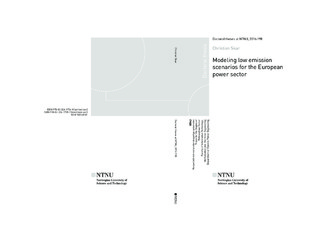| dc.contributor.advisor | Doorman, Gerard | |
| dc.contributor.author | Skar, Christian | |
| dc.date.accessioned | 2016-08-19T07:05:14Z | |
| dc.date.available | 2016-08-19T07:05:14Z | |
| dc.date.issued | 2016 | |
| dc.identifier.isbn | 978-82-326-1735-7 | |
| dc.identifier.issn | 1503-8181 | |
| dc.identifier.uri | http://hdl.handle.net/11250/2399924 | |
| dc.description.abstract | The long-term ambition for the European power sector is to almost completely decarbonize
generation of electricity. There are potentially many ways of achieving this, however, assessing
an optimal transition to a low-carbon power system requires the use of advanced modeling tools.
This thesis presents a collection of papers addressing various topics related to capacity expansion
modeling of the European power system. The aim of the modeling is to evaluate cost-efficient
decarbonization strategies. The most significant contribution of this work is the development
of the European Model for Power system Investments (with high shares of) Renewable Energy,
EMPIRE. This is a multi-horizon stochastic programming model where investments are optimized
subject to operational uncertainty. The model simultaneously considers long-term and
short-term system dynamics, in addition to short-term operational uncertainty. Inclusion of all
these features is currently not used by any other capacity expansion model for the European
power sector.
The papers presented here focus on the formulation and applications of EMPIRE. Essentially
all the papers touch upon analysis of decarbonization pathways for the European power sector.
In addition, the role of carbon capture and storage (CCS) for decarbonizing the European power
sector is analyzed in one paper. In the same paper, an evaluation of support mechanisms for
enabling investments in demonstration CCS projects is presented. Another topic covered is
integration of global climate change mitigation strategies computed by an integrated assessment
model (IAM) in a study of the European power sector. This is handled through soft-linking of
the IAM called GCAM and EMPIRE. By linking top-down and bottom-up models in this way,
added detail can be provided to the IAM results. One paper presents a study where capacity
factors from EMPIRE are used in life cycle assessment of electricity generation technologies in
Europe. Improved estimations of utilization of different generation technologies can make the
LCA impact analysis more accurate.
In addition to the aforementioned topics, the thesis presents a contribution to the development
of convergence improvements for the Benders decomposition method applied to large-scale power
system investment planning problems. Also, a technique for improved handling of seasonal
storage in power system capacity expansion models is discussed.
The modeling studies show that large-scale deployment of wind power and carbon-capture
and storage is the most cost-efficient approach to decarbonize the European power sector. Intermittent
power generation should be built where the production potential is highest, and the
transmission system should be reinforced to be able to balance large fluctuations in renewable
production. If the transmission system is not developed, CCS becomes more important in the
decarbonization as less wind power can be deployed. In order to secure investments in demonstration
CCS plants financial support policies are needed. Investments in solar PV are limited in
these studies, suggesting that additional cost reductions are needed for the technology to become
competitive without support policies. | nb_NO |
| dc.language.iso | eng | nb_NO |
| dc.publisher | NTNU | nb_NO |
| dc.relation.ispartofseries | Doctoral thesis at NTNU;2016:198 | |
| dc.relation.haspart | Paper A:
Skar, Christian; Doorman, Gerard L.; Tomasgard, Asgeir.
The future European power system under a climate policy regime. I: ENERGYCON 2014 : IEEE conference proceedings 2014 s. 318-325 - Is not included due to copyright available at
<a href="http://dx.doi.org/10.1109/ENERGYCON.2014.6850446" target="_blank"> http://dx.doi.org/10.1109/ENERGYCON.2014.6850446</a> | |
| dc.relation.haspart | Paper B:
Skar, Christian; Doorman, Gerard L.; Tomasgard, Asgeir.
Large-scale power system planning using enhanced Benders decomposition. I: 18th Power system Computations Conference - PSCC 2014. Curran Associates, Inc. 2014. s. 89-95 - Is not included due to copyright available at
<a href="http://dx.doi.org/10.1109/PSCC.2014.7038297" target="_blank"> http://dx.doi.org/10.1109/PSCC.2014.7038297</a> | |
| dc.relation.haspart | Paper C:
Brovold, Sondre; Skar, Christian; Fosso, Olav B.
Implementing Hydropower Scheduling in a European Expansion Planning Model. I: Renewable Energy Research Conference, RERC 2014. Energy Procedia Vol 58, s.117-122
<a href="http://dx.doi.org/10.1016/j.egypro.2014.10.417" target="_blank"> http://dx.doi.org/10.1016/j.egypro.2014.10.417</a>
(CC BY-NC-ND 3.0) | |
| dc.relation.haspart | Paper D:
Skar, C., G. L. Doorman, G. A. Pérez-Valdés, and A. Tomasgard. 2016. “A multihorizon
stochastic programming model for the European power system.”
<a href="https://www.ntnu.no/censes/working-papers" target="_blank"> CenSES Working paper 2/2016</a> | |
| dc.relation.haspart | Paper E:
Skar, C., G. L. Doorman, G. Guidati, C. Soothill, and A. Tomasgard. 2016. “Modeling
transitional measures to drive CCS deployment in the European power sector.”
<a href="https://www.ntnu.no/censes/working-papers" target="_blank"> CenSES Working paper 1/2016</a> | |
| dc.relation.haspart | Paper F:
Bouman, E. A., C. Skar, and E. G. Hertwich. 2016a. “Informing LCA of electricity
technologies with a power market model.” - Is not included due to copyright | |
| dc.title | Modeling low emission scenarios for the European power sector | nb_NO |
| dc.type | Doctoral thesis | nb_NO |
| dc.subject.nsi | VDP::Technology: 500::Electrotechnical disciplines: 540::Electrical power engineering: 542 | nb_NO |

